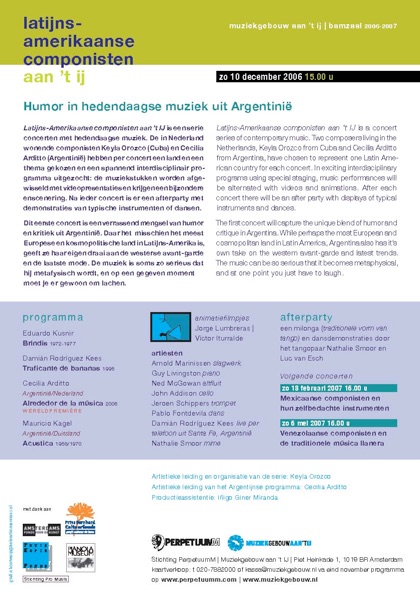La arquitectura del aire / The architecture of air (2009)
for organ and two percussionists
comissioned by Orgelpark, Amsterdam
“La arquitectura del aire” is about the space between things. The two percussionists and the organ form a triangle spread out in the hall, with the organist is situated above, and the percussionists spaced far apart on the ground level.
The three musicians create an invisible perimeter, which becomes the playground for air, in different conditions and states. A ventilator, a melodica, and an old radio exchange concrete air sounds in the form of fluctuations and noise bands.
The organ has a motor and pipes, and the vibraphone also has a motor and pipes, initiating a dialogue of frequencies primarily composed of air and electricity.
As the performance progresses, the performers define the space’s perimeter by playing string telephones. These instruments connect the three players through sound while also creating a visual line in the three-dimensional space, reaching the top of the organ. In a game of analogies, the humble tin from the string telephone communicates with the organ pipes, which share a similar nature.
This music is about the “in-betweens.” It is music crafted from air and threads, essentially composed of nothing, where the musicians tie sounds with strings and send signals to each other using their instruments, motors, and voices: a cathedral of air.
Related post/s in my blog
“Arquitectura que canta” (Español)
“Los músicos de La arquitectura del aire” (Español/English)
“La arquitectura del aire and the program notes” (English)
“Estreno de La arquitectura del aire, para órgano y dos percusionistas (Español)
“Los asistentes” (Español)
“Pan comido” (Español)
“Listen to me” (Español)
“La vida pende de un hilo” (Español)
“La función hace al órgano” (Español)
“La vista flaca” (Español)
Related works:
• Gestalt (2014)
• Esta tarde leo a Adorno/This afternoon I read Adorno (2013)
• Time machine (2011)
• El libro de los gestos / Book of gestures (2008)
• Split piano (2011)
• Gespleten piano (2010)
La arquitectura del aire / The architecture of air (2009) Read More »

